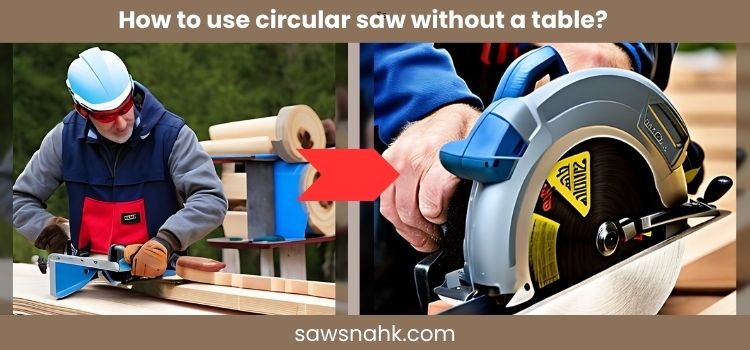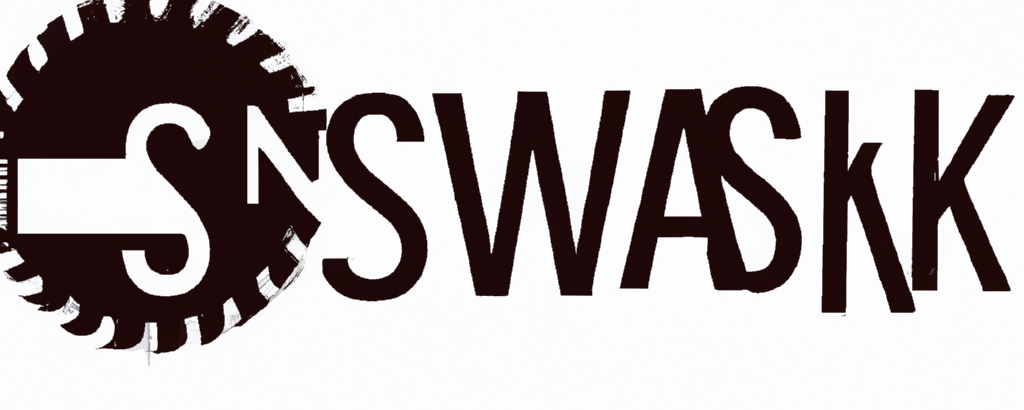How to use a circular saw without a table? 4 Secrets Methods

Have a circular saw but no table? Don’t worry – you can still create amazing projects. Using a circular saw without a table might seem tricky, but we’ve got you covered with simple methods that anyone can follow.
You can use any of these four methods: Using Foam Insulation Sheets, Using Sawhorses, the Structural Lumber Method, and the DIY Track Technique.
Get more out of your circular saw, even without a table! Learn easy and effective ways to make awesome projects with no hassle. Let’s begin!
Things You Need To Know Before Using Circular:
Here are a few things you need to know about circular saws before the excellent cut quality and safety of cutting with a circular saw.
Supporting the materials:
It can be difficult to keep plywood or dimensional lumber stable and supported when cutting it because you are on both sides of the cut line. You want to avoid any vibration or shifting of the material.
It will be very unsafe, and your cut line will also be disturbed. Plywood will always support the sheet; you must clamp it in dimensional lumber.
Support the saw blade:
The most important part of cutting with a circular saw is ensuring the material is supported across the cut line. If not, it will cause blade binding or kickbacks.
Blade binding occurs when a rotating blade becomes caught in the wood being cut. When excessive twisting occurs, the blade becomes trapped and can result in kickbacks.
Another reason to keep the cut line supported is from collapsing into the cut. This can cut the splinter, rip it apart, and produce undesirable cut quality.
Space for the saw blade:
When setting the circular saw, fix the saw blade, such as ¼’’ below the bottom of the cut surface. You should be able to cut whatever you want on the board.
If you don’t have a table saw, don’t worry; you can utilize any of these methods.
Using Foam Insulation Sheets Without A Table:
Get the Goods:
Score a 4×8 foam sheet, usually in pink or white. Easy to find, and it’s your secret weapon.
Set the Stage:
Lay that foam sheet down flat, whether it’s on the floor or a solid concrete surface. This is your cutting arena.
Place and Prep:
Pop your material on top of the foam. Make sure it’s chillin’ flat and snug.
Mark Your Territory:
Break out the pencil and straightedge to mark where the cut’s going down. Precision, baby!
Saw Magic:
Align the circular saw blade with your cut line. Engage safety mode, grab those handles, and let the saw do its thing.
Smooth Moves:
Glide that saw along the marked line, slow and steady wins the race. Keep it under control, and you’ll be the DIY champion.
Piece it Together:
Once the cut’s a wrap, gently lift your masterpiece from the foam stage.
Using Sawhorses:
Material Prep:
Pop that material on a pair of sawhorses. No wobbling allowed, make it snug!
Mark Your Territory:
Break out the pencil and speed square. Mark that cut line like a boss.
Depth Check:
Adjust the blade depth to match your material thickness. We want a clean cut, not a tease.
Saw Setup:
Align the saw’s baseplate with your cut line. Keep it steady, keep it flat – the material’s counting on you.
Material Lockdown:
Firm grip on the saw, and with your other hand, press down. Your material should feel like it’s on lockdown against those sawhorses.
Cutting Showtime:
Hit the saw’s power button and start the show. Guide that saw along the marked line, with the finesse of a DIY maestro.
Finish Line:
Keep the momentum. Cut until that material is waving goodbye to its old self.
Safety Swagger:
Don the safety gear – glasses, gloves, and kick-butt footwear. Safety first, DIY second.
Structural Lumber Method:
Material Check:
Grab two pieces of dimension lumber (think 2x4s) and a sturdy work buddy, like a plywood sheet.
Lumber Love:
Lay those lumber pieces side by side on your work surface, creating a power-packed support team.
Hold it Tight:
Clamp your material down on the lumber support. We want a tight grip, no material escape artists here!
Mark Your Territory:
Break out the pencil or a marking tool. Draw that cut line on the material – show it who’s boss!
Depth Dive:
Set your saw’s blade depth a bit deeper than your material’s thickness. We’re going all the way, baby!
Saw Stance:
Grip that circular saw like a champ. One hand on the back, one on the front – you’re in control.
Line it Up:
Make your saw’s baseplate buddies with the cut line. They should be parallel to the lumber support. Friends forever!
Power Play:
Flip the switch and gently drop that blade onto the material. It’s showtime!
Pressure Party:
Apply steady pressure, and guide the saw along the cut line. You’re the captain of this cutting ship.
Finish Strong:
Keep guiding until the cut is a wrap. Release the trigger, and let the blade take a breather.
Safety Dance:
Gear up with safety glasses, ear protection, and gloves. Safety’s the VIP at this DIY party!
DIY Track Technique:
Track Prep:
Grab a straight piece of plywood, and be its superhero. Clamp it to your workpiece; it’s your guide, your North Star for straight and clean cuts.
Mark Your Territory:
Whip out the measuring tape, and mark that cut line. Precision starts here.
Plywood Pals:
Align the plywood’s straight edge with your cut line. Clamp it down, and make it stick like glue.
Saw Stance:
Set your saw’s depth – it’s a match with your workpiece’s thickness. No surprises here, we want perfection.
Grip and Go:
Hold that saw tight. Switch it on – let the DIY symphony begin. Glide along the plywood track like a boss.
Track Triumph:
Follow your cut line religiously. The plywood track has your back, ensuring a journey of stability and precision.
Caution, Captain:
Safety gear is your superhero cape. Goggles and ear protection – suit up before you cut up.
DIY Confidence:
No table? No problem! With the DIY Track Technique, you’re the circular saw maestro, crafting woodworking wonders without missing a beat.
Safety Tips For Using a Circular Saw Without a Table
Gear Up Right:
Start with the basics. Grab those safety essentials – wear safety glasses to shield your eyes, pop on ear protection to dial down the saw’s noise, and slip into sturdy gloves for hand protection.
Grounded Work:
Give your project a solid base. Place it on a flat, secure surface. This simple step minimizes the chance of slips or unexpected moves while you’re in the cutting zone.
Material Lockdown:
Don’t let your material play hopscotch. Secure it with clamps or any trusty fastening method. A stable material means you’re in control, ensuring precise and accurate cuts.
Cut Line Etiquette:
Before the saw sings, mark your territory. Clearly draw that cut line on your material. This visual guide keeps you on track, steering clear of mistakes or straying off the intended path.
Blade Wisdom:
Set the saw blade’s depth just right. Match it with or slightly exceed the material’s thickness. It’s the secret sauce for a clean, efficient cut without putting your saw or yourself at risk.
Grip Power:
Hold that circular saw like you mean it. Both hands, one on the rear handle, one on the front. It’s your ticket to stability and control throughout the cutting fiesta.
Switch On, Switch Off:
Be a boss with the power switch. Only engage it when the blade is clear of the material. Release the trigger and let the blade take a bow before lifting it off the workpiece. No accidental starts or stops here.
Space Awareness:
Eyes on the prize, but also on your surroundings. Ensure there’s enough room for material and saw dance moves. Kick-tripping hazards to the curb and keep bystanders at a safe distance.
Tool TLC:
Your circular saw needs love too. Regular check-ups and maintenance keep it sharp, lubed, and all safety features in top-notch shape.
Pace Yourself:
Don’t rush the cut. Maintain a calm and controlled pace as you guide the saw. Speed demons invite mistakes; let’s keep it safe and steady.
Instruction for the Accuracy of the Circular saw:
Whether you are an expert or a beginner, using these instructions, you will get fantastic accuracy for your cut using the Circular Saw.
- Remember the board’s support over the sawhorses so they can not tip over or fall.
- In darker work, the mask tape line will help you highlight.
- Masking tape before drawing can reduce splinters and give a pleasant finish.
- More teeth on the saw will give a better cut but take longer; large teeth mean a rough cut.
- Use a sharp blade with the appropriate number of teeth.
- Use rasp or sandpaper to sharpen the blade.
Conclusion:
In summary, becoming skilled in using a circular saw without a table offers numerous opportunities for DIY fans. The techniques outlined, including using foam insulation sheets, sawhorses, structural lumber, and the DIY track method, offer accessible options for achieving precision and creativity in your projects.
Understanding important factors like material support, blade support, and sufficient space ensures safety and optimal cutting outcomes. Remembering to dress appropriately and follow safety guidelines, such as grounding your work, securing materials, and maintaining tool integrity, adds an extra layer of assurance.
FAQS:
Can I Make My Circular Saw Into A Table Saw?
No, you cannot convert a circular saw into a table saw. They are different tools with distinct designs and functions.
How Do You Cut Wood Straight Without A Table Saw?
To cut wood straight without a table saw, you can use a straightedge or a guide clamped onto the wood as a cutting guide for your circular saw. This will help you maintain a straight-cutting line.
Can I Make My Circular Saw Into A Table Saw?
No, you cannot convert a circular saw into a table saw. They are different tools with distinct designs and functions.
